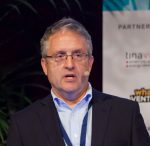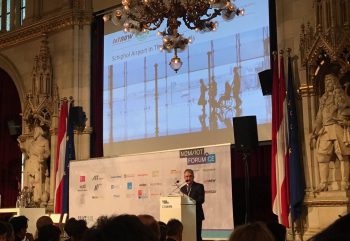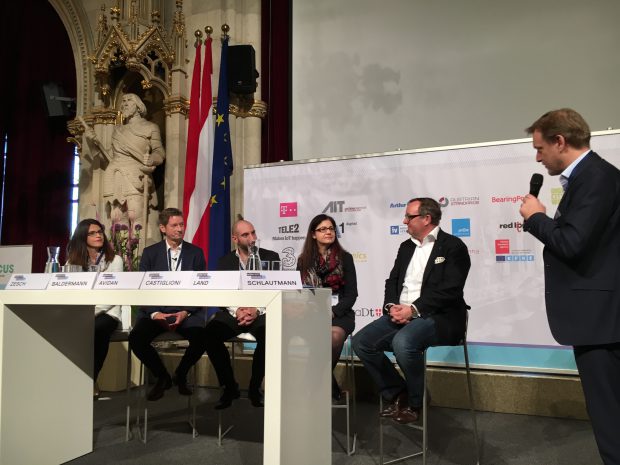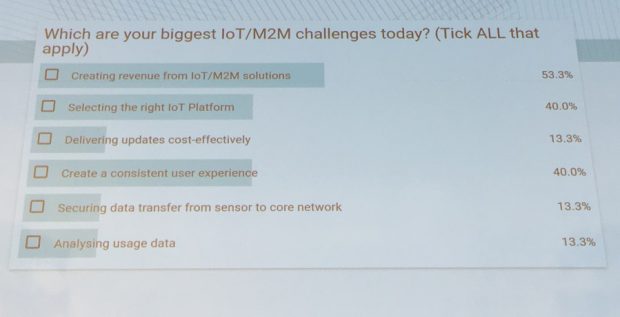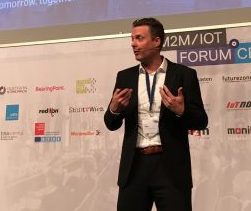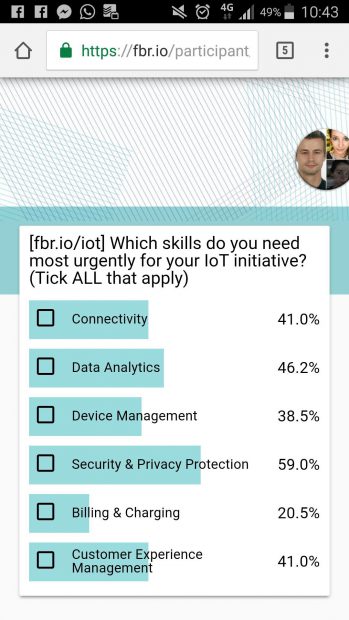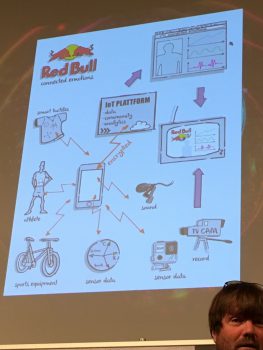Vienna plans to use 1.8m brains in new smart city, as Central Europe forum focuses on industrial IoT
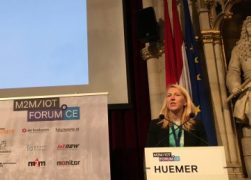
Ulrike Huemer, Vienna’s CTO
When everyone’s nose is pressed to the grindstone, it is good to be reminded of the benefits of what we are doing in the Internet of Things (IoT).
Ulrike Huemer, the City of Vienna’s CTO and the keynote speaker on Day One, put it well. The Austrian capital is investing heavily in information and communications technology (ICT) and IoT. As Jeremy Cowan reports from this week’s M2M/IoT Forum CE 2017, held in the palatial City Hall, Vienna is determined to become one of Europe’s leading smart cities, and is already home to more than 6,000 ICT companies employing 54,000 people.
“As an industry,” said Huemer, “ ICT is four times more profitable than tourism,” another of the city’s major revenue streams. In 2016 the city launched a new smart city and digitalisation strategy. “Unlike some smart cities in places like Asia,” she said, “our new technology will be citizen-focused.
We have said we have 1.8 million brains in the city, let’s use them. So, we will see what they need. We have published 400 datasets, and developers have published more. Crowd-sourcing has given us 26 new use cases for Smart City Vienna.” She expects that in a decade 30,000 people will be living in a dedicated smart city district.
As moderator of the event, your correspondent was invited to discuss current trends in the industry and focused on the need to encourage legislators, standards bodies and business models to catch up with technology advances in IoT.
“It’s no coincidence that some of the most interesting IoT deployments in recent months have come in LPWA (low-power wide area) networks for industrial campuses, universities, and the armed forces, where using unlicensed spectrum meant there was no need to wait for new standards to emerge from 3GPP or oneM2M.”
Among the examples given was Telensa’s roll-out of LoRa connections for the fleet of wheelchairs at Schiphol Airport in The Netherlands. Previously, it was impossible to reliably locate wheelchairs when they were needed for moving passengers to and from their planes. By adding LoRa-enabled sensors, not only could the wheelchairs be found, the wheelchair fleet was reduced.
A panel of five industry experts, including four telecom network operators, was grilled on stage by Ansgar Schlautmann of consultants Arthur D Little and a common theme quickly emerged – it’s hard to get small to medium-sized enterprises (SMEs) to develop their digital strategies, as Maria Zesch, chief commercial officer of T-Mobile Austria put it. The CEO of rival operator A1 digital, Dr Elisabetta Castiglioni added that IoT is about making better use of existing assets.
Schlautmann suggested that network operators are moving slowly. Castiglioni didn’t agree. Rami Avidan, head of the IoT/M2M business for Tele2, conceded that telcos now know they need different business models, not just the small, medium or large supply of SIMs (subscriber identity modules). “We’re not selling end-to-end services,” he said. “No-one is. We need partners and we need different partners for different services.”
Karl-Heinz Land, the founder of neuland GmbH and co-author of the book Digitaler Darwinismus, commented, “Decide what is core to your business, and if it can be done by software become a software developer today! It can be done, look at the hardware company,Bosch. They now have 23,500 software developers.”
Looking ahead, the panel welcomed Narrowband-IoT standards. NB-IoT will be half the operating cost of LoRa and Sigfox, said Matthias Baldermann, CTO of Hutchison Drei Austria.
“So, what’s the message to the 47% of the population that some estimates suggest will be without a job in 2030?” asked Ansgar Schlautmann. According to Land, it’s synonymous with the title of his forthcoming book, Inconvenient Truth. There will be jobs if you want them, but Land is predicting a future in which we may all be working as little as 25 hours a week and in which he adds (poignantly in Brexit week) there are no national borders.
Festo’s Dr Cynthia Klett echoed this era of greater productivity in her presentation on Industry 4.0. She works in product development, on the boundary between technical innovation and business development. An automated industrial manufacturing network, she said, enables the production of personalised goods for every single one of us at “near mass-production costs”.
Volker Hager of ThyssenKrupp, a manufacturer of elevators, described his company’s continuing journey from Corrective Maintenance to Preventive to Predictive and finally to Prescriptive Maintenance. Data is now captured, transferred, stored and analysed for further action. The firm is currently retrofitting lift connectivity systems worldwide, starting with 50,000 elevators in Germany, Spain and the US.
This is for more than just an emergency calls, the system sends operational monitoring data to central servers and even enables engineers equipped with augmented reality (AR) headsets to repair and service elevators with visual guidance from expert engineers at headquarters. This not only cuts the number of unnecessary truck rolls but means that senior engineers can advise more teams, enhancing service productivity and providing a better service to customers.
This is for more than just emergency calls, the system sends operational monitoring data to central servers and even enables engineers equipped with augmented reality (AR) headsets to repair and to service elevators.
They can receive visual guidance from expert engineers at headquarters. This not only cuts the number of unnecessary truck rolls but means that senior engineers can advise more teams, enhancing service productivity and providing a better service to customers.
Before Day Two’s expert panel, Josef Kranawetter, an entrepreneur and managing director at Weidmuller, an international company specialising in industrial connectivity and automation, was thanked by the organiser, Helmut Blocher, for generously paying offset charges that neutralised the entire event’s carbon footprint. Kranawetter then stressed the need for industrial IoT (IIoT) to develop greater skills in research & development and to deploy IoT in more use cases.
Dr Klett called for greater transparency between ecosystem partners in sharing innovations and said that IIoT needs a flatter hierarchy to accelerate deployments.
Also on the panel, Wolfgang Leindecker, vice president of Sales & Industrial Corporate Marketing at TTTech Computertechnik AG in Vienna, stressed the importance for all industries of progressing from internet protocol (IP) to real-time communications, to optimise the use of sensor data.
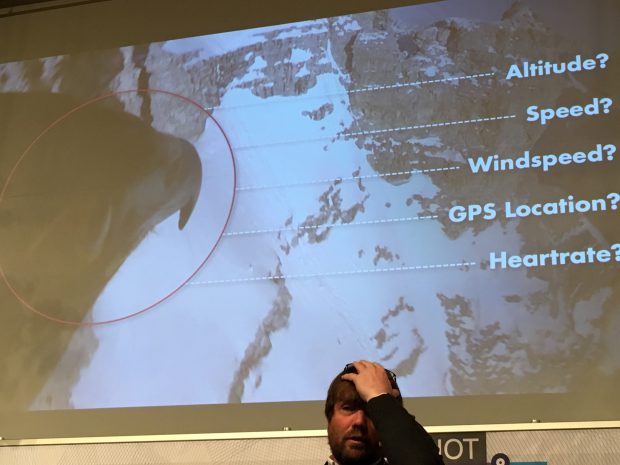
Face palm moment: Red Bull’s Andy Gall realised after the first flights that their ‘connected eagle’ should incorporate data feeds
At times in Andreas Gall’s presentation, it may have seemed the lighter side of the Internet of Things, but Red Bull‘s chief innovation officer may be playing the most important role of all if he can help to convince public opinion that IoT is relevant to them. For reasons that initially remained cloudy (but which we hope to get him to blog about here) Red Bull has managed to connect an eagle.
After several attempts, it was possible to attach an internet-connected camera to the back of a bird and film its viewpoint. Aside from creating some truly stunning video images it has helped the team to learn how to connect, film and stream back data in extreme environments, including skydiving, ice hockey matches, mountain biking, and extreme skiing.
The author is Jeremy Cowan, editorial director & publisher of IoT Now, IoT Global Network, and VanillaPlus.
Comment on this article below or via Twitter @IoTGN

